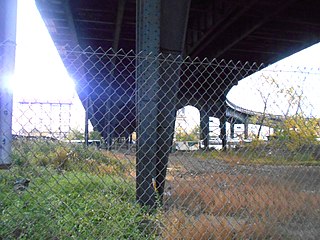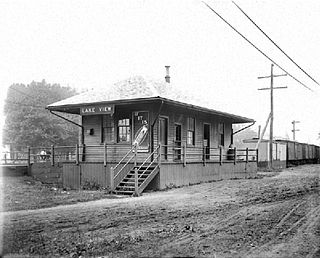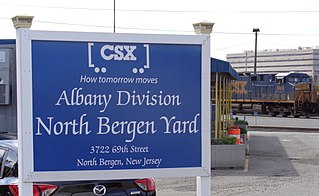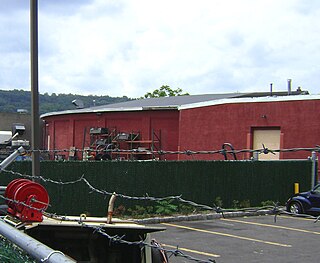
North River is an alternative name for the southernmost portion of the Hudson River in the vicinity of New York City and northeastern New Jersey in the United States.

The Main Line is a commuter rail line owned and operated by New Jersey Transit running from Suffern, New York to Hoboken, New Jersey, in the United States. It runs daily commuter service and was once the north–south main line of the Erie Railroad. It is colored yellow on NJ Transit system maps, and its symbol is a water wheel.

Marion Junction is a railroad junction in western Jersey City, New Jersey. Currently, it connects CSX's River Line to Conrail's Passaic and Harsimus Line. The two lines merge towards the west, allowing through trains from upstate New York to continue towards the rest of the country. The track actually making the connection is known as the Marion Running Track.

Susquehanna Transfer was a passenger station on the New York, Susquehanna and Western Railway, located in North Bergen, New Jersey located at what today is the Route 495 overpass. It was an interchange station where transfer was possible from the railroad to a bus through the Lincoln Tunnel to the Port Authority Bus Terminal in Midtown Manhattan.

For the purposes of this article, the Jersey City area extends North to Edgewater, South to Bayonne and includes Kearny Junction and Harrison but not Newark. Many routes east of Newark are listed here.

The Northern Branch is a railroad line that runs from Jersey City to Northvale in northeastern New Jersey, and formerly extended further into New York State. The line was constructed in 1859 by the Northern Railroad of New Jersey to connect the New York and Erie Railroad's Piermont Branch terminus in Piermont, New York, directly to Erie's primary terminal in Jersey City, initially Exchange Place, later Pavonia Terminal. In 1870 the line was extended to Nyack, New York, and continued to provide passenger service until 1966. After the Erie's unsuccessful merger with the Lackawanna Railroad to form the Erie-Lackawanna, ownership of the line passed into the hands of Conrail upon its formation in 1976 from a number of bankrupt railroads.

The Newport station is a station on the PATH system. Located on Town Square Place at the corner of Washington Boulevard in the Newport neighborhood of Jersey City, New Jersey, it is served by the Hoboken–World Trade Center and Journal Square–33rd Street lines on weekdays, and by the Journal Square–33rd Street line on weekends. As of 2017, its estimated weekday use was nearly 20,000 passengers, up from 17,000 to 18,000 average weekday passengers in 2010.

The Pennsylvania Railroad Station was the intermodal passenger terminal for the Pennsylvania Railroad's (PRR) vast holdings on the Hudson River and Upper New York Bay in Jersey City, New Jersey. By the 1920s the station was called Exchange Place. The rail terminal and its ferry slips were the main New York City station for the railroad until the opening in 1910 of New York Pennsylvania Station, made possible by the construction of the North River Tunnels. It was one of the busiest stations in the world for much of the 19th century.

The Central Railroad of New Jersey Terminal, also known as Communipaw Terminal and Jersey City Terminal, was the Central Railroad of New Jersey's waterfront passenger terminal in Jersey City, New Jersey. The terminal was built in 1889, replacing an earlier one that had been in use since 1864. It operated until April 30, 1967.

Pavonia Terminal was the Erie Railroad terminal on the Hudson River located in the Harsimus section of Jersey City, New Jersey. The station opened in 1861 and closed in 1958 when the Erie Railroad moved its passenger services to nearby Hoboken Terminal. The New York, Susquehanna and Western Railway also ran commuter trains from the terminal and various street cars, ferries and the underground Hudson and Manhattan Railroad serviced the station. The station was abandoned in 1958 and demolished in 1961. The site was eventually redeveloped into the Newport district in the late 20th century.

Weehawken Terminal was the waterfront intermodal terminal on the North River in Weehawken, New Jersey for the New York Central Railroad's West Shore Railroad division, whose route traveled along the west shore of the Hudson River. It opened in 1884 and closed in 1959. The complex contained five ferry slips, sixteen passenger train tracks, car float facilities, and extensive yards. The facility was also used by the New York, Ontario and Western Railway. The terminal was one of five passenger railroad terminals that lined the Hudson Waterfront during the 19th and 20th centuries; the others were located at Hoboken, Pavonia, Exchange Place and Communipaw, with Hoboken being the only one still in use.

The Pavonia Ferry was a ferry service on the Hudson River, operating between New York City and Jersey City, New Jersey, United States. It was launched in 1854. It was sold to the Pavonia Ferry Company of Jersey City for $9,050 at New York City Hall in February 1854.

Lake View is a former railroad station for the Erie Railroad in the community of Paterson, New Jersey. The station was located at the intersection of Railway Avenue and Crooks Avenue in the Lakeview district of Paterson, just north of the Clifton town line. The station consisted of two platforms, with a small shelter-sized depot on the westbound tracks and no shelter whatsoever on the eastbound side heading towards Pavonia Terminal. The station was first opened in 1883 in the Lakeview district, and remained in use for nearly eight decades. In 1952 and 1953, as a deal made for Passaic, New Jersey, stations at Clifton and Main Street-Passaic were rebuilt. However, Lake View was not, and when the Passaic Plan was enacted on April 2, 1963, the last passenger trains served Lake View served the old 1883 depot. The depot was razed in the autumn of 1967.

The North Bergen Yard is freight rail yard and intermodal terminal in North Bergen, New Jersey parallel to Tonnelle Avenue between 49th and 69th Streets. Located within the North Jersey Shared Assets Area, the facility is part of CSX Transportation (CSXT) and the origination point of its CSX River Subdivision at the southern end of the Albany Division. On its west side, the New York, Susquehanna and Western Railway (NYSW) runs the length of the yard and operates a bulk transloading operation immediately adjacent to it.
The Newark Branch was a branch of the Erie Railroad in New Jersey, United States, running between Jersey City and Paterson and passing through the Broadway Section in North Newark, the origin of its name. Inaugurated in the 1870s, the line was last used for passenger service on September 30, 1966, but continues to be used for freight service on a portion of its length.

North Hawthorne, known as North Paterson when originally constructed, was a rail station and yard located in Hawthorne, Passaic County, New Jersey. The facility, which was equipped with car and engine shops, served passengers and freight for both the Erie Railroad and the New York, Susquehanna and Western Railroad from 1892 to 1966. Passenger service from North Hawthorne primarily transported commuters to and from the Susquehanna Transfer station in North Bergen or the Erie Railroad's Pavonia Terminal in Jersey City. Connecting service included the now defunct Public Service Railway, which at one time used North Hawthorne as the terminus of a trolley line connecting Hawthorne to Paterson. Once a sizable complex with multiple spurs and sidings for surrounding industries, North Hawthorne has been reduced to a single runaround siding. Every structure associated with the yard has been demolished, except for the roundhouse, which today is owned by private interests.

Ridgefield Park station, also known as West Shore Station, was a railroad station in Ridgefield Park, New Jersey, at the foot of Mount Vernon Street served by the New York, Susquehanna and Western Railroad (NYSW) and the West Shore Railroad, a division of New York Central (NYCRR). The New York, Ontario and Western Railway (NYO&W) had running rights along the West Shore and sometimes stopped at Ridgefield Park. First opened in 1872 it was one of three passenger stations in the village, the others being the Little Ferry station to the south and Westview station to the north. Service on the West Shore Railroad began in 1883. The station house, built at a cost of $100,000 opened in 1927. Southbound service crossed Overpeck Creek and continued to terminals on the Hudson River waterfront where there was a connecting ferry service across the Hudson River to Manhattan. Northbound near Bogota the parallel NYSW and West Shore lines diverge and continue into northern New Jersey, Pennsylvania, and upstate New York. Passenger service ended in 1966.

Hackensack was a railroad station in Hackensack, New Jersey on the New York, Susquehanna and Western Railway Main Line, which provided passenger service between the 1870s and 1960s. The station at Main and Mercer Streets opened in 1872; it was replaced with one at River Street in 1950. Public Service trolley lines served both stations.

Bogota was a railroad station in Bogota, New Jersey, at Court Street/Fort Lee Road west of River Road and east of the Court Street Bridge over the Hackensack River. It was located on the New York, Susquehanna and Western Railway Main Line, which provided passenger service between the 1870s and 1960s.

North Newark was a former commuter railroad train station in the Woodside section of the city of Newark, Essex County, New Jersey. Located at the intersection of Broadway and Verona Avenue, the station served trains on NJ Transit's Boonton Line, which operated at the time between Netcong and Hoboken Terminal. The station consisted of two low-level side platforms, accessible by stairs from Broadway. The next station to the east was Arlington in nearby Kearny, with the next station to the west being Rowe Street in Bloomfield.























